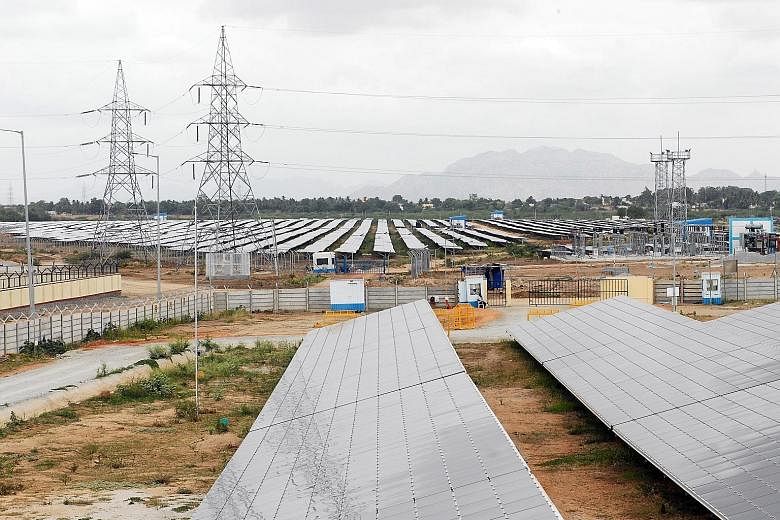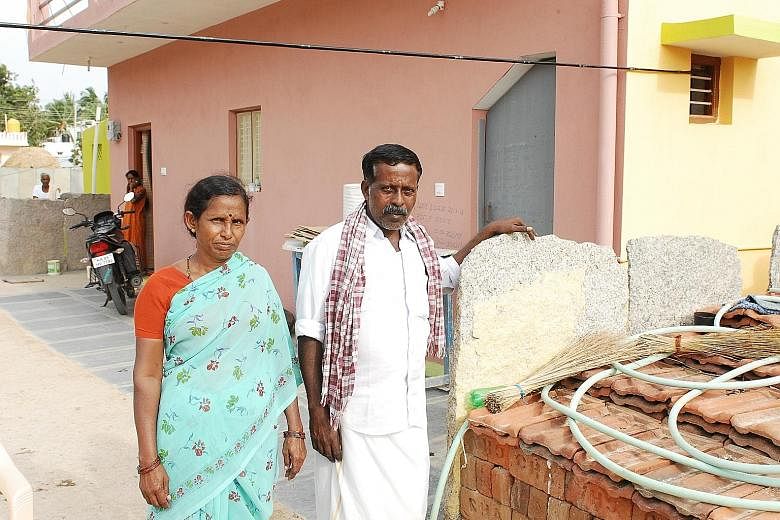The sun's pitiless heat is often thought of as a curse in the village of Pavagada. You can see why. Barren land, littered with rocks and small shrubs, stretches up to the craggy hills on the horizon.
Crop losses here, in one of southern India's worst drought-hit regions, have mounted over the years, forcing farmers to move to cities. Little could be done to turn around the fate of this unforgiving place.
And so it was, until the state government decided to exploit the only resource available in plenty - sunshine - and began constructing a solar power plant in 2016.
Today, Pavagada is the site of the world's largest solar farm. Shakti Sthala is spread over 5,200ha - the size of more than 8,000 football fields - and will have a capacity of 2,000 megawatts when completed by July next year.
Instead of groundnut crops that once struggled to grow, countless solar panels shimmer, while wind turbines whirr at an adjacent wind energy farm. This change is symbolic of India's transformation into a world leader of renewable energy.
Long considered a slow-mover against climate change, India is today rapidly expanding its renewables generation capacity as it seeks to reduce reliance on carbon-emitting fuels responsible for warming the planet and also causing an epidemic pollution crisis in the country.
India has doubled its renewable energy capacity from 35.51 gigawatts (GW) to 72.69 GW in the past 41/2 years. This is set to rise to 175 GW by end-2022 - an official target of the Indian government.
"We are not only confident, but sure that we would exceed the set target," said Mr Anand Kumar, Secretary of the Indian Ministry of New and Renewable Energy. "By 2030, considering that the demand for electricity is expected to grow at about 6.5 per cent every year, we propose to install more than 500 GW of renewables generation capacity," he told The Sunday Times.
India already ranks fourth globally in wind energy generation capacity and fifth in solar.
LOW PER-CAPITA POWER USAGE
India's per-capita electricity consumption levels are the lowest among major economies - an average Indian consumes around 1,200 kilowatt hours (kwh) annually.
The country's total power demand, however, is expected to increase 2.7 times by 2050, said Mr Shantanu Jaiswal, the head of India Research at Bloomberg NEF (New Energy Finance), as it seeks to provide access to energy for all and raise living standards.
Renewables will ensure India - the world's third-largest emitter of greenhouse gases - makes this transition as sustainably as possible. "The potential of solar energy, which India is blessed with, is humongous for this country and for the betterment of this country," said Mr Ashish Khanna, managing director and CEO of Tata Power Solar, one of the firms that have set up plants at Pavagada. "And it is not just the need for lighting. India also needs water, sanitation - all of them need power," he added.
The 2017-2018 fiscal year was the first during which India installed more renewables capacity than non-renewables. It added around 11.78 GW of renewable energy capacity, more than double the 5.4 GW of capacity in the latter. By comparison, Singapore's total power generating capacity is 13.6 GW.
"What India is trying to do with renewables in seven to 10 years is what took Germany - a much more advanced economy - more than 20 years to achieve," said Dr Arunabha Ghosh, founder-CEO of the Council on Energy, Environment and Water, a New Delhi-based think-tank.
This drive is also being feted globally. "If you look at the global market, India really sticks out in terms of its ambition level, the political drive and target setting for renewable energy," said Mr Morten Dyrholm, group senior vice-president of Vestas, a Danish wind energy firm that operates in India.
FIRST OFFSHORE WIND FARM
Today, one sees solar panels practically everywhere in India - on rooftops, trains and even lakes and canals. The renewables sector is set for another leap as India moves ahead with its plans to set up its first offshore wind farm.
"The current estimate for wind potential (in India) is over 300 GW and we've only tapped 10 per cent of this potential," said Mr J.P. Chalasani, CEO of Suzlon Group, a wind energy solutions firm.
India has already committed to switching 40 per cent of its installed electricity capacity to nonfossil fuel-based energy resources by 2030 under the Paris Agreement. At the moment, it accounts for around 21 per cent of total installed capacity. If large hydroelectricity projects of more than 25 MW in size are included as renewables - they are not considered so at the moment and a proposal is under way to give them the renewable status - this capacity increases to around 35 per cent.
Mr Kumar said adopting renewable energy is "a matter of conviction and faith" for India. "It is also making commercial and economic sense now. Solar and wind power is becoming cheaper than the variable cost of coal," he told The Sunday Times.
A strong government push for renewables, together with aggressive competition, has sent generation costs plummeting. Open auctions have yielded tariffs as low as 2.44 rupees (0.04 Singapore cent) for each unit (kwh) of solar energy and 2.43 rupees for wind power - among the lowest rates in the world. This is cheaper than generating electricity with a new coal-fired plant.
The airport at Kochi in Kerala, recipient of this year's UN Environment Programme Champions of the Earth Award, is one of the many institutions reaping the benefits of adopting solar energy. It is the world's first airport to be fully powered by solar energy. The airport saves around one million rupees daily in electricity bills, which helps it recoup costs of each phase of expansion of its solar plant in around six years.
This energy revolution has caught up with NTPC Ltd, a public sector energy behemoth that produced 23 per cent of India's electricity in the last financial year. Known for its stubborn reliance on coal, it too is jettisoning coal-fired plants and setting up new wind and solar farms as the latter become more viable. It opened its first wind farm last September, a 50 MW one, and has a target of moving 30 per cent of its 130 GW capacity to renewables by 2032.
NOT OVER YET FOR COAL, THOUGH
But despite this "greening" of India's energy mix, the future for coal isn't bleak. Not yet, at least. It generates more than three-quarters of India's electricity and is expected to remain the country's main source of power for more than a decade. India's demand for the "black gold", in fact, rose 7.5 per cent in the year ending March 2018.
The country is also one of the world's largest coal producers - an industry that supports the livelihoods of at least 10-15 million people, according to Dr Rohit Chandra, an energy researcher who focuses on the coal sector. This has allowed coal to develop "deep institutional roots", something he argues will be difficult to wean India away from.
Moreover, the upbeat narrative around renewables often eclipses the sobering fact that they, with the exception of large hydroelectricity projects, still account for just 10.62 per cent of India's actual generation of electricity. This is because of the intermittent nature of both the sun and wind. Coal, therefore, will keep playing a critical role as a "balancing power", said Mr Kumar, till it's more affordable to store renewable energy. "As and when storage becomes cheaper, we will move towards round-the-clock power from renewables and a gridfree regime perhaps," he added.
Besides acquiring land, the poor financial health of power distribution firms in India is another challenge. "Had they had good balance sheets, they would have invested in innovative practices and technologies and consumed more of renewables. But this is not happening," said Mr Jaiswal.
Policy control measures such as import duties and imposition of tariff ceilings in tenders have also dimmed enthusiasm among energy developers, already burdened with intense competition to keep prices low.
Taking renewable energy in India from "mainstream to majority", argued Dr Ghosh, will require lowering capital costs for distribution firms to ensure they do not go out of business, as well as reducing costs for energy developers and consumers. "The more we deepen our financial markets, our debt markets, our green bond markets, our green investment windows, our currency and policy risk hedging mechanisms, the more we will be able to drive down the cost of renewables."
If India remains faithful to meeting its power needs in "the most economical and sustainable way", Bloomberg NEF's modelling shows that coal emissions from the power sector will peak in 2033. "This is also when renewables will take over from coal as the primary source of electricity. We might also achieve peak power sector emissions in India during that time," added Mr Jaiswal.
Many in India, and indeed around the world, are hoping this momentous landmark will come about sooner rather than later.
Correction note: This article has been edited for clarity.


